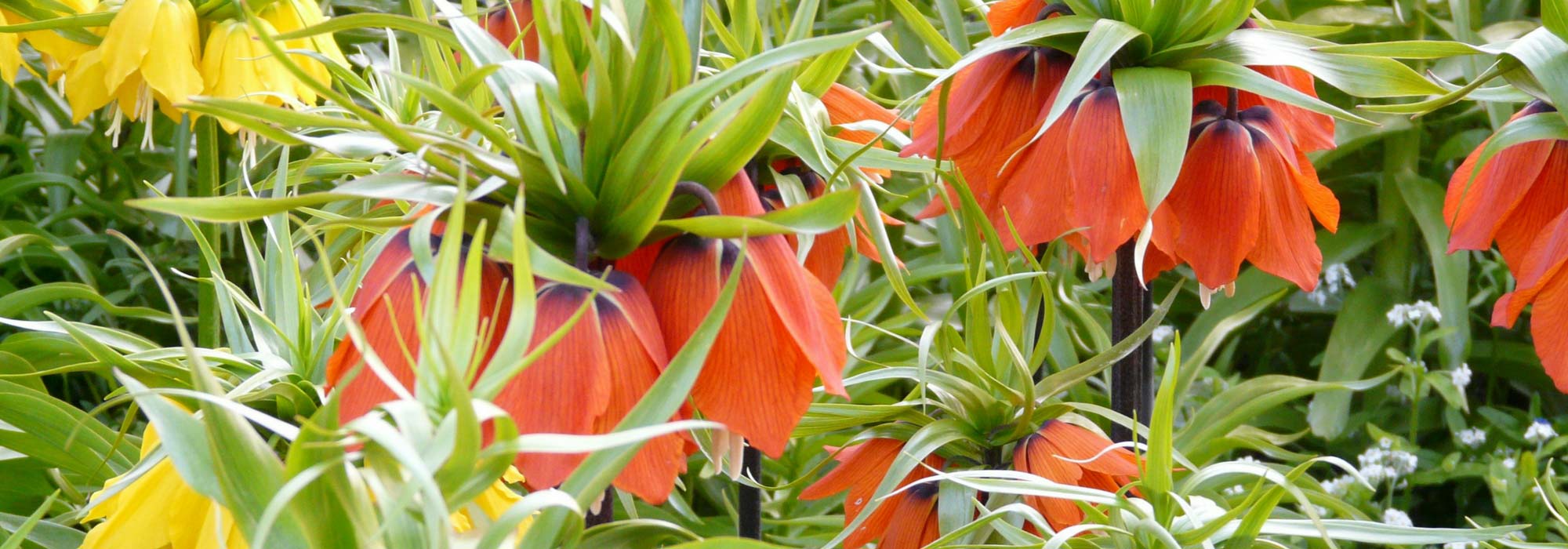
Fritillary: planting, cultivation, maintenance
Summary
Fritillaries in a nutshell
- Their spring flowering is very spectacular
- They grow in full sun or partial shade
- It is the ultimate mole-repelling bulb
- Easy to cultivate in well-drained soil
- Hardy, the bulbs remain in the ground for many years
A word from our expert
Alongside rare and wild species such as the Pyrenean Fritillary, there are tolerant and easy-to-grow species of Fritillaries in our gardens. If Fritillaria imperialis brings to mind the imperial crown in a copper vase, the famous painting by Vincent Van Gogh, this imposing and architectural spring bulb also inevitably draws all eyes in the garden.
In March, for the earliest varieties and until May, their bell-shaped flowers, usually red-orange, purple, sometimes white or patterned like a checkerboard, emerge from grassy tufts to herald the arrival of spring.
Whether they are Fritillaria imperialis, Guinea Fritillary or méléagris, Persian Fritillary, Fritillaria uva-vulpis, their spring flowering never goes unnoticed. Ranging from 20 cm to 1.5 m in height, fritillaries can be placed anywhere according to their growing requirements, whether in borders, pots, along pathways, at the base of deciduous trees, in rockeries, or scattered throughout the short grass meadow.
The Imperial Crown or Fritillaria imperialis has been used for a long time against moles. This beautiful repellent emits a strong odour in the soil that deters rodents, but that’s not its only advantage: it is one of the largest spring bulbs!
With their atypical, highly structured silhouette and crown-shaped yellow or orange flowers, Imperial Crowns add height and exotic accents to your borders and centrepieces. The smaller varieties, such as Fritillaria michailovskyi, are easy to grow in sunny border beds, rockeries, or pots.
In non-burning sun or partial shade, they thrive in all our gardens, where some easily naturalise, forming flowering clumps over time. In the heart of spring, they create scenes filled with originality or simplicity alongside other spring bulbs, such as daffodils, jonquils, wood anemones, hyacinths, or tulips.
Discover all their planting and care secrets, as well as our collections of Fritillaries, some of which are very rare and exclusive varieties perfect for transforming a sunny border, brightening a rockery, flowering a cool woodland, or creating beautiful spring planters.
Botany
Botanical data sheet
- Latin name Fritillaria
- Family Liliaceae
- Common names Fritillary, Imperial Crown, Guinea Fowl Fritillary
- Flowering from March to June
- Height 0.15 to 1.50 m
- Sun exposure Sun, partial shade
- Soil type ordinary well-drained
- Hardiness -5°C to -15°C depending on species
The genus Fritillaria includes around a hundred species of bulbous perennials native to temperate regions of the Northern Hemisphere, particularly around the Mediterranean, southwestern Asia, and western North America. They belong to the lily family, like lilies, squills, or daffodils.
The Fritillaries comprise numerous species divided into tall fritillaries with stems reaching 1.50 m in height, medium ones between 40 and 70 cm, and small fritillaries not exceeding 20 cm tall. All bloom in spring.
In our gardens, about fifteen cultivated species offer a very eclectic choice for gardeners, both in terms of very different cultivation requirements from one species to another and appearance. The needs of fritillaries vary so much that we generally distinguish the more tolerant species from those native to woodlands that prefer moist soil and small species that do not tolerate humidity.
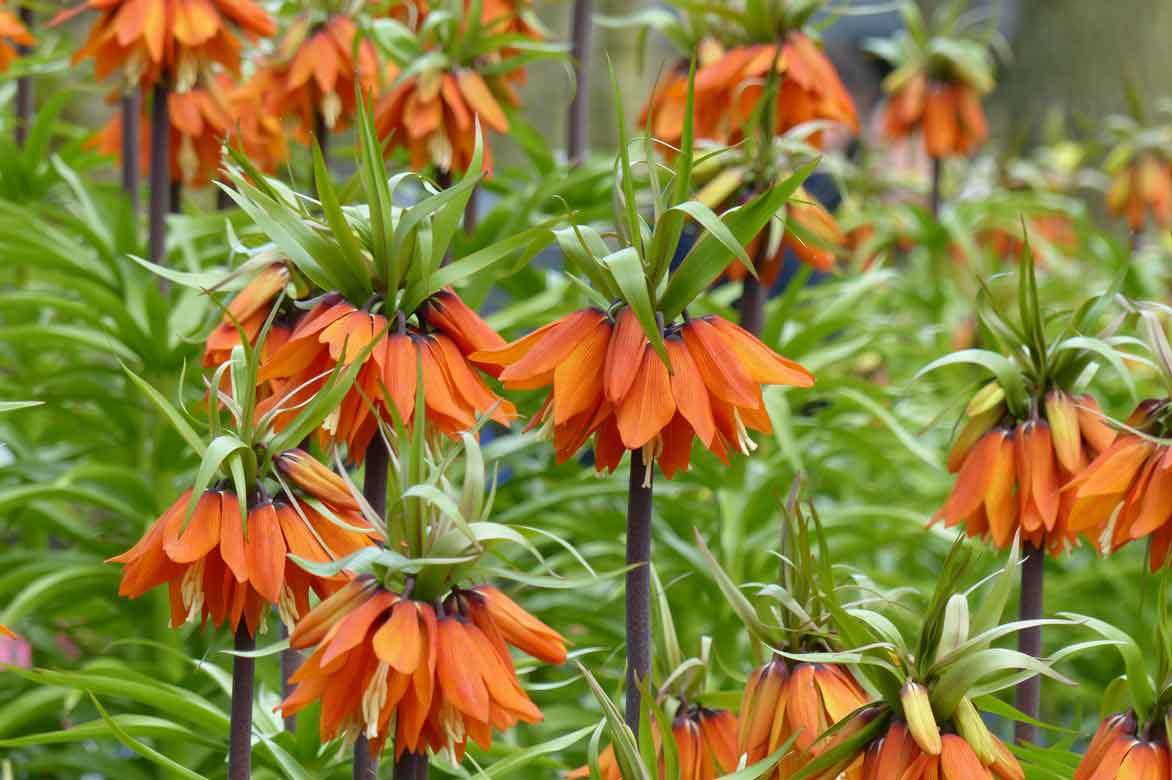
The Imperial Fritillary or Imperial Crown is the best-known and most imposing of the genus.
All adapt very well to our climates. The best-known and most commonly planted is undoubtedly the Imperial Fritillary or Imperial Crown, native to southern Turkey to Kashmir, with yellow or orange crown-like flowers and lovely light green or variegated white or golden foliage. It is now available in about ten varieties with rich colours, including the must-have Fritillaria imperialis Aureomarginata and Imperial Fritillary ‘Rubra’.
We also find fritillaria meleagris known as “guinea fowl fritillaries” or “guinea fowl egg”, with their pretty bells all white or with a very pronounced checkerboard pattern and the tall Persian fritillaries in white or black.
The Fritillaria bucharica with star-shaped flowers, fritillaria uva vulpis, Fritillaria michailovskyi, and Fritillaria hermonis ssp. Amana are small bulbs of less common or rarer species. Some, like the “guinea fowl fritillary” or wild fritillaries, are now protected species in their natural habitat.
The bulbs of fritillaries of varying sizes have at least two scales and sometimes many bulbil at the base. In spring, when in vegetation, the bulbs enter dormancy and rest in summer, indifferent to heat and drought. As soon as the soil suits them and they are not disturbed, they multiply over time, reliably blooming each year on slopes, in rockeries, or borders.
Beneath their majestic appearance, fritillaries are true repellents: they are the ultimate mole-repelling bulb! Once underground, their large bulbs emit an unpleasant odour within a radius of 1.5 m that deters rodents.
They form more or less erect clumps depending on the species, from which emerge rigid stems of 0.15 to 1.50 m in height. The deciduous leaves measure 2 to 20 cm long. They are bright green, dark green to very glaucous grey-green, sometimes shiny or rough. Some varieties have lovely bright green foliage variegated with golden yellow. Each bulb produces linear, alternate, lanceolate leaves, sometimes narrow. They are longer at the base and more or less numerous along the flowering stem. They can be well spaced on the stem and become scarcer at the top. The “guinea fowl egg” fritillaries develop gramineous foliage.
Some, like the imperialis, are topped with a tuft of upright green leaves above the flowers, giving them a beautiful exotic appearance: a tuft that earns this species the name “imperial crown”. After flowering, the leaves yellow and fall to the ground, then the foliage quickly disappears in summer, leaving the bulb dormant underground.
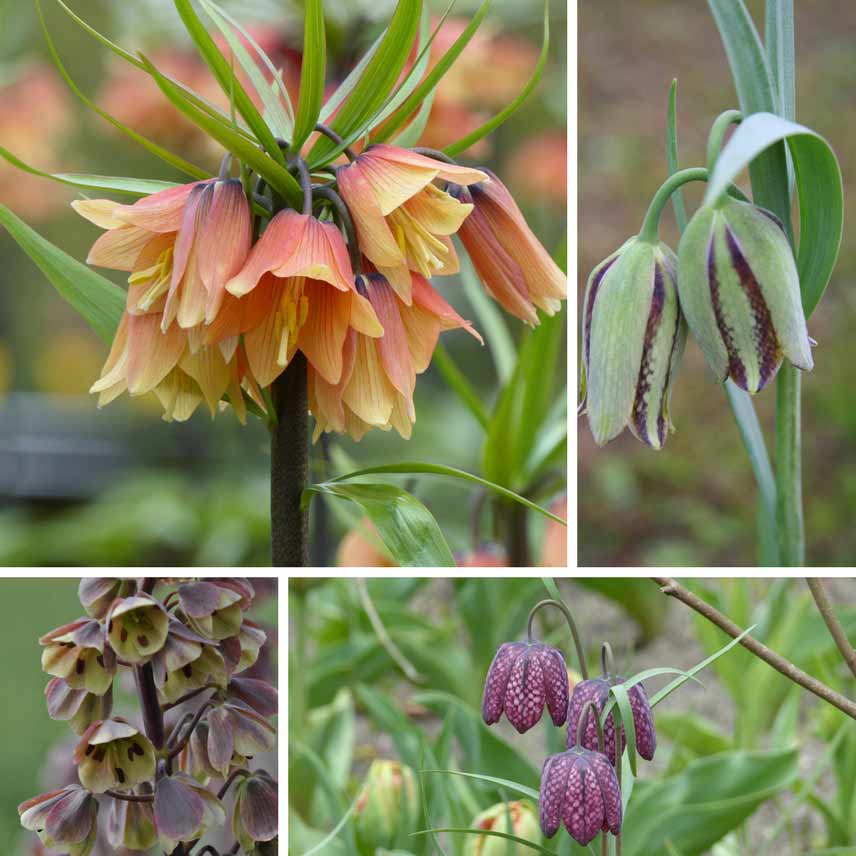
Fritillaria imperialis ‘Orange beauty’ – Fritillaire hermonis ssp. amana – Fritillaire persica Bicolor – Guinea Fowl Fritillary or Fritillaria meleagris
The extraordinary and early flowering of fritillaries never goes unnoticed. It begins in March, at the same time as that of daffodils and the first tulips, with the peak occurring in April, ending in May, with the arrival of summer heat. Fritillaries are among the first large bulbs to bloom in spring.
The flowers appear solitary or grouped in pairs of 2 or 3 or in spikes of 20 to 30 flowers or in crowns at the tips of the well-erect stems. They take the form of pendulous bells delicately veined and sometimes swollen, measuring 4 to 5 cm in diameter or star-shaped flowers. Some bear floral stems over 30 cm long.
The heart of the petals of the imperial fritillary contains nectaries, that is to say, stamens producing drops of nectar, hence the nickname “the weeping flower”.
The unscented flowers come in colours that are sometimes dark, almost black, purplish, or green, sometimes vibrant oranges, yellows, or red-orange, sometimes silver-white or cream in the Fritillaria imperialis Raddeana.
The Fritillaria meleagris, known as ‘Guinea Fowl Fritillary’, offers a particularly recognisable flowering with its bells printed with a subtle dark pink or greenish checkerboard pattern. Some are beautifully contrasted, like the fritillaria uva vulpis with its deep red flowers edged in golden yellow and the Fritillary hermonis ssp. amana where the green petals are alternately tinged with a discreet plum checkerboard.
After flowering, the flowers dry and form fruits in the form of very decorative winged capsules that release tiny black seeds that self-sow spontaneously.
Most of these spring-flowering bulbous plants are hardy and withstand cold very well down to -10-15°C, easy to grow, provided they have very well-drained soil and a warm, sunny location, but not necessarily in direct sunlight. They prefer fertile soils. Apart from woodland and wet prairie species, they thrive ideally in a continental climate where winters and summers are dry and springs are humid.
Majestic and imposing, fritillaries inevitably attract attention when planted in groups. The tallest species structure and add height to the centres and back of borders or mixed borders with tulips or late cream or white daffodils.
They will shine in association with medium-sized shrubs like lilacs, deciduous azaleas, and Japanese cornels. The varieties with vibrant flowers stand out in combinations of warm colours like peach or apricot, with orange and scarlet.
The muted tones of some fritillaries pair well with pink, mauve, white, or blue flowers of Siberian squills, muscari, primroses, for example, and with the purplish leaves of heucheras. They are splendid alongside hostas and early-flowering euphorbias.
Small fritillaries illuminate any scree garden or rockery, a sunny flowerbed, or a raised bed as long as one can admire their elegant inclined flowers up close. They also naturalise in lawns or at the foot of deciduous trees. They can be grown in pots to enjoy them even on the terrace.
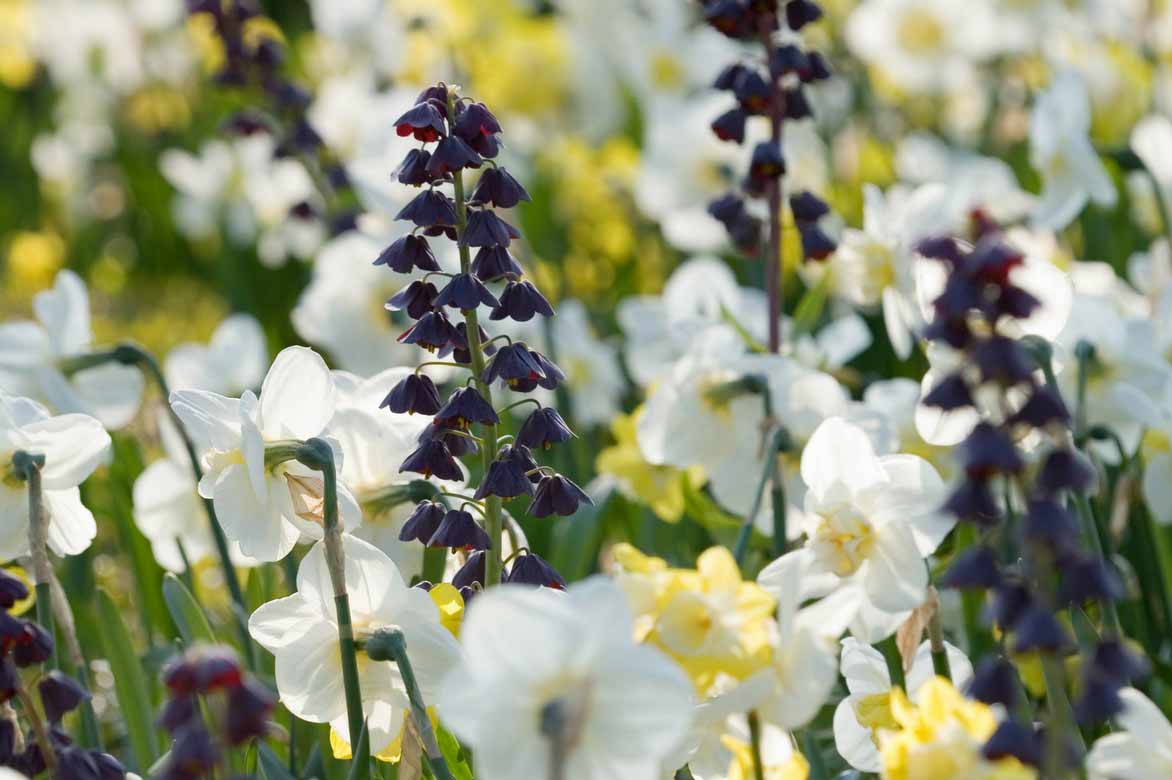
The tall sturdy stems of Fritillaria persica Adiyaman are accompanied by shorter plants to be able to admire their graphic foliage and characteristic pendulous flowers from all angles.
You may also read
Fritillaries: how to plant and care for themSpecies and varieties
Fritillaries have been classified into 4 groups according to their cultivation requirements. They are also distinguished by the height of their stems, ranging from 15 cm for the shortest species to nearly 1.50 m for the tallest, such as the Crown Imperial or Fritillaria imperialis.
- Group 1: these are cold-resistant species that are tolerant of summer drought, such as the Imperial Fritillary (Fritillaria imperialis) and its cultivars, the Persian Fritillary (Fritillaria persica), the Pale-flowered Fritillary (Fritillaria pallidiflora), Fritillaria uva-vulpis, and Radde’s Fritillary (Fritillaria raddeana). They thrive in full sun but require a fertile, well-drained soil! They are well-suited for a sunny flowerbed or a rock garden.
- Group 2: these are fairly robust species like Fritillaria acmopetala but cannot tolerate rain during their dormancy period and therefore prefer dry soils in summer. They enjoy the sun and thrive in very well-drained, low-fertility soil. They are ideal for rock gardens, raised beds, or even greenhouses.
- Group 3: these are species native to humid forests and meadows, such as the Guinea Fowl Fritillary (Fritillaria meleagris) and the Kamchatka Fritillary (Fritillaria camschatcensis). They should be planted in full sun or under light shade, in a fertile soil that retains water in summer. They are best grown in regions where summers are cool and humid. They are the easiest and probably the least demanding.
- Group 4: this group includes small species like Fritillaria michailovskyi and the Amana Fritillary (Fritillaria hermonis ssp. amana) that do not tolerate moisture. They should be grown in full sun in cool, fertile, well-drained soil, protected from rain, ideally under a frame or in a cold greenhouse to keep the bulbs dry during their dormancy period.
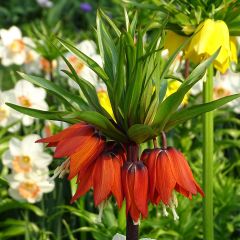
Fritillaria imperialis Rubra
- Flowering time may, june
- Height at maturity 90 cm
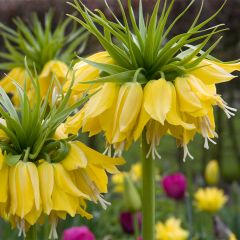
Fritillaria imperialis Lutea
- Flowering time may, june
- Height at maturity 90 cm

Fritillaria imperialis Aureomarginata
- Flowering time may
- Height at maturity 75 cm
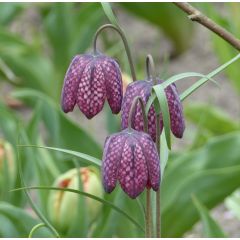
Fritillaria meleagris - Snake's Head Fritillary
- Flowering time april, may
- Height at maturity 25 cm
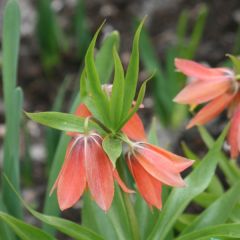
Fritillaria imperialis Bach
- Flowering time may, june
- Height at maturity 70 cm

Fritillaria raddeana
- Flowering time may
- Height at maturity 80 cm
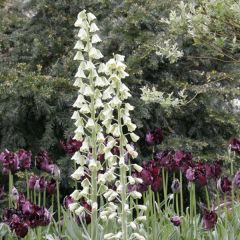
Fritillaria persica Ivory Bells
- Flowering time may, june
- Height at maturity 70 cm
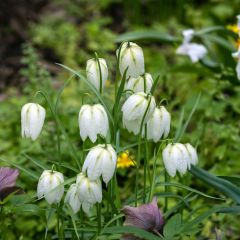
Fritillaria meleagris Alba
- Flowering time april, may
- Height at maturity 25 cm
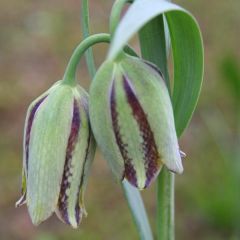
Fritillaria hermonis subsp. amana
- Flowering time may, june
- Height at maturity 25 cm
Discover other Fritillaria
View All →Available in 2 sizes
Available in 0 sizes
Available in 0 sizes
Available in 1 sizes
Available in 1 sizes
Available in 1 sizes
Available in 1 sizes
Available in 1 sizes
Available in 1 sizes
Young plantation
Where to plant?
Depending on the species, Fritillaries have very different needs. Most prefer to be planted in full sun or under light shade in very well-drained fertile soil.
They thrive, except for species that enjoy moisture, ideally in a continental climate where winters and summers are dry and springs are humid.
Versatile, Fritillary bulbs fit into all settings and will naturalise in light woodland, at the foot of deciduous trees and bushes, on a bank, along a path, or in rockeries; it is essential to allow their foliage to completely wither before cutting it back.
With their architectural habit, tall species like the Imperial Fritillary and the Persian Fritillary should be planted out of strong winds, at the back or centre of a border where they provide height and an original focal point.
The smaller fritillaries, such as Fritillaria uva-vulpis and Fritillaria michailovskyi, are easy to grow and insert easily into borders, rockeries, or pots.
Moisture-loving species like the Guinea Fritillary should be planted in woodland where they will easily naturalise, or perhaps by the edge of a pond.
Grow species that dislike moisture in pots or in a greenhouse, sheltered from rain.
After flowering, Fritillaries dry out quickly and display withered foliage that can be easily masked by planting them with hardy geraniums, pulmonarias, or euphorbias.
Fritillary bulbs emit a strong scent and make good repellents for rodents; they are traditionally planted among tulip beds, whose bulbs are highly prized by these small mammals.
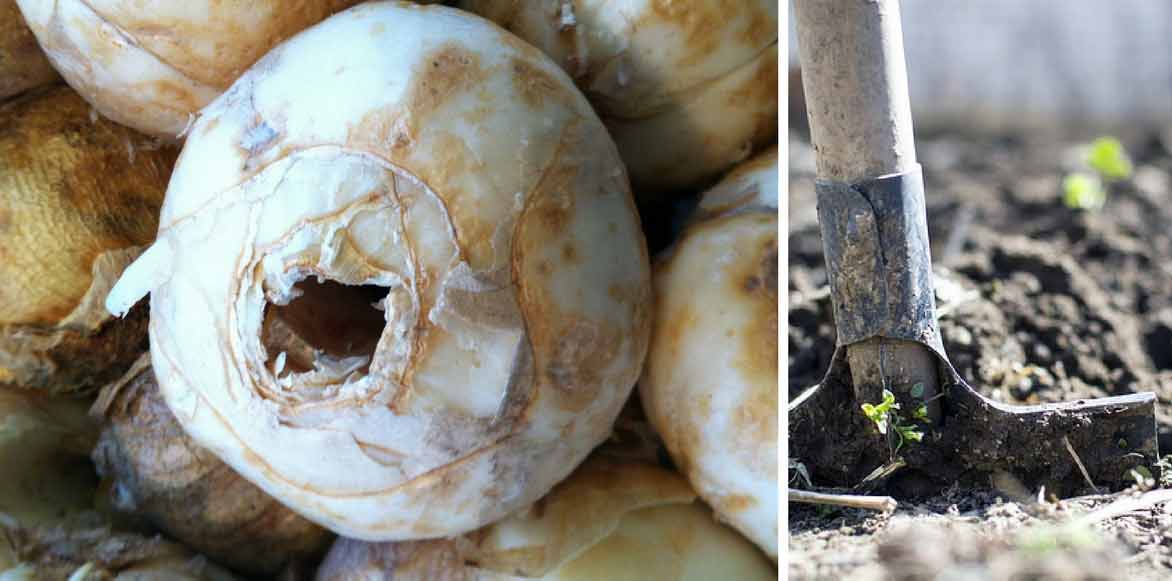 The large hollow bulbs at the top of the fritillaria imperialis retain moisture and are very sensitive to rot if drainage is insufficient
The large hollow bulbs at the top of the fritillaria imperialis retain moisture and are very sensitive to rot if drainage is insufficient
When to plant
Ideally, Fritillary bulbs should be planted in early autumn, in September-October, especially for the Impérialis, which are delicate and quickly deteriorate when out of the ground. Other fritillaries can be planted until November at the latest.
How to plant
Quickly after purchase! Fritillary bulbs are prone to drying out and rotting, so they should be planted without delay in rich, very well-drained soil as fritillaries dislike standing water and heavy soils, which can lead to fungal issues.
One precaution: before planting, check the specific cultural needs of the chosen species, as they differ among varieties. Varieties like Fritillaria meleagris, which prefer cool, heavy soils, should be planted in a border or a moist rockery, under shrubs or in a lawn.
In open ground
Large fritillaries should be planted in small groups of 3 or 5 at most for a natural look. Smaller varieties like Fritillaria meleagris deserve to be planted in abundance (up to 100 bulbs per m²), in a lightly mown lawn or as a flowering carpet at the foot of deciduous shrubs for a spectacular effect.
- Loosen the soil deeply with an addition of organic matter (bulb fertiliser)
- In heavy soil, improve drainage with gravel or pumice mixed into the soil or laid in a 5 to 10 cm thick bed under the bulbs
- Plant carefully at about 3 times the height of the bulb, 10-20 cm deep, with the tip of the bulb facing upwards (plant the hollow bulbs of fritillaria imperialis at an angle to avoid rot)
- Space large bulbs 30 cm apart, small ones 10 cm apart, ensuring they do not touch
- Cover the bulbs with soil
- Keep dry in summer
- Leave the bulbs in place; they will flower again year after year
A mass planting
Some small fritillaries, such as Fritillaria meleagris, naturalise very easily. When planted in numbers, they are perfect for creating flowering spots around the house, in borders, at the edge of woodlands, or at the foot of trees. For mass planting, count 50 to 100 bulbs per m² depending on the desired density. Dig the planting area to a depth of 20 cm, then place the bulbs spaced about 5 to 10 cm apart and backfill.
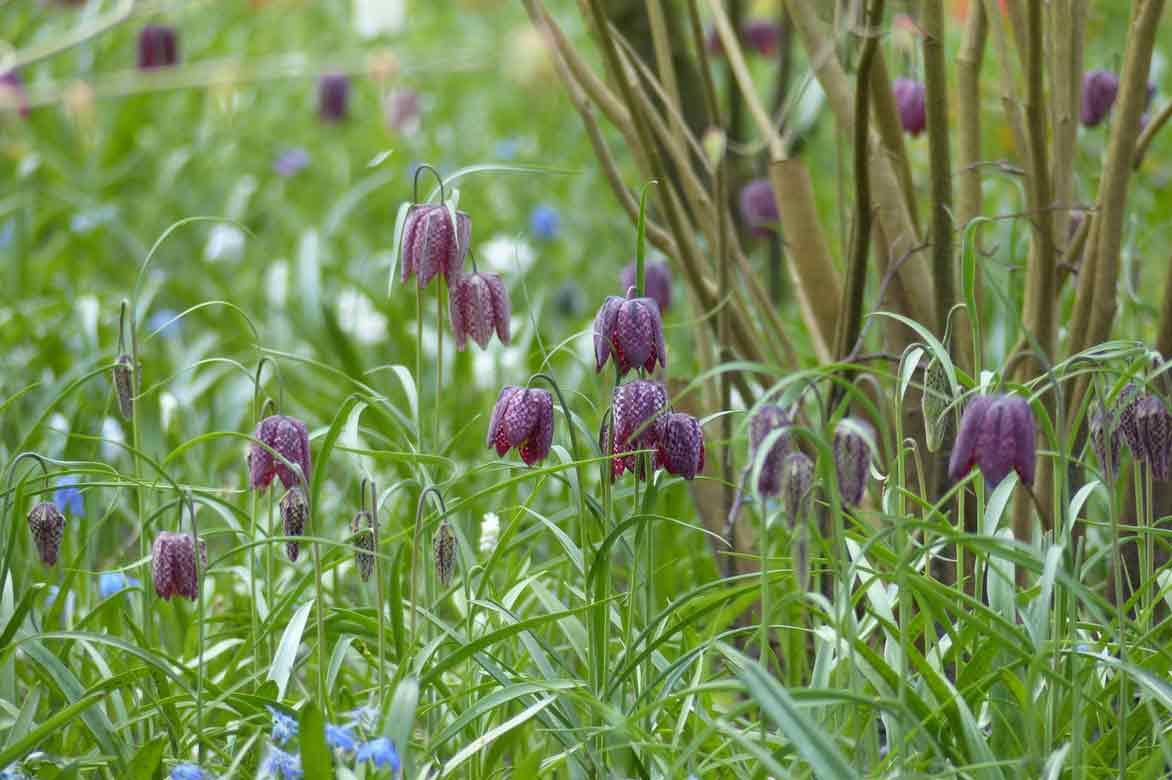 Fritillaria meleagris naturalise very easily at the foot of trees, creating beautiful flowering carpets over the years
Fritillaria meleagris naturalise very easily at the foot of trees, creating beautiful flowering carpets over the years
In pots
Fritillary bulbs are easy to grow in pots to enjoy their spring flowering on the terrace or balcony.
- Spread a layer of clay pebbles at the bottom of a perforated pot (preferably in soil) for perfect drainage
- Fill with a light, well-draining mix made up of half garden soil, a quarter leaf mould, and a quarter gravel or pumice
- Plant the bulbs 20 cm deep, covering with three times their height of soil
- Water once a week during the growing season, then stop watering in summer during the resting period when the foliage begins to yellow
→ Learn more in our advice sheet: Growing imperial fritillaries in pots.
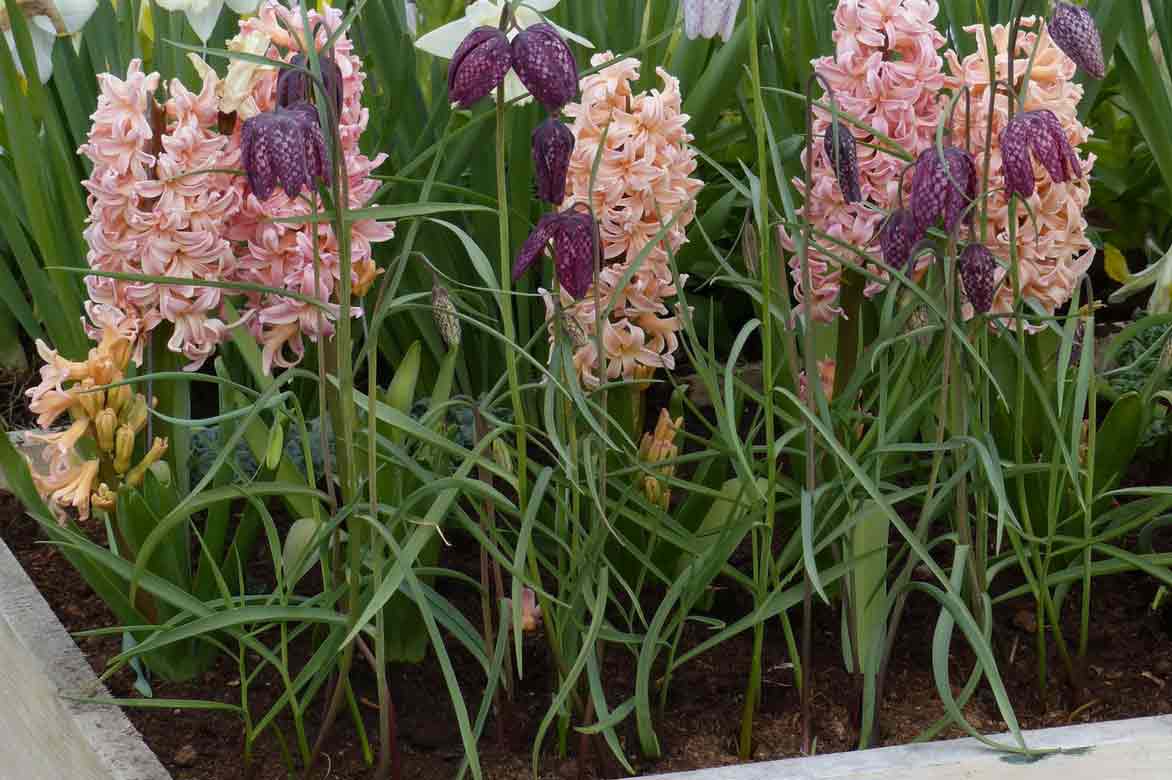 In pots, plant fritillary bulbs with hyacinth bulbs, squills, snowdrops, muscari, small daffodils, or miniature cyclamen.
In pots, plant fritillary bulbs with hyacinth bulbs, squills, snowdrops, muscari, small daffodils, or miniature cyclamen.
You may also read
Succeeding in planting fritillariesMaintenance and care
Fritillaries are accommodating plants that require little care. In windy areas, do not hesitate to stake tall species if necessary. Water only during growth, leave the bulbs dry during summer; except for Fritillaries from wet environments, leave them alone and stop all watering during the summer dormancy period.
No pruning is necessary, however, to limit self-seeding, you can cut the flower stems after flowering. Do not mow or cut the foliage back to the ground until it is completely faded, to allow the bulb time to rebuild its reserves needed for the next flowering.
Potted subjects will need to be fertilised regularly and repotted every two years in autumn: after flowering, apply a bulb fertiliser or an organic fertiliser.
In very cold regions, mulch the soil surface with dried leaves to protect the bulbs from frost. Some, such as Fritillaria michailovskyi, are not very hardy and should be protected from cold and moisture in winter with good mulching.
Clumps of Fritillaries lose vigour as they age and disappear quickly, often within three years: beyond four years, flowering becomes weak. Do not hesitate to apply organic fertiliser at the base of the clump every three years as soon as the leaves emerge from the ground.
Pests and potential diseases
Fritillaries are perennial bulbous plants resistant to diseases in well-drained soil. Aside from excess moisture, which causes bulb rot, they are primarily threatened by gastropods that feast on their young leaves before they even emerge from the ground in spring. A slug treatment, applied at planting and then every year from February onwards, is imperative.
Fritillaries have another known and formidable enemy: the lily beetle, a small red beetle that loves the scent emitted by fritillaries and devours leaves and flower buds, sometimes leading to complete defoliation of the plant.
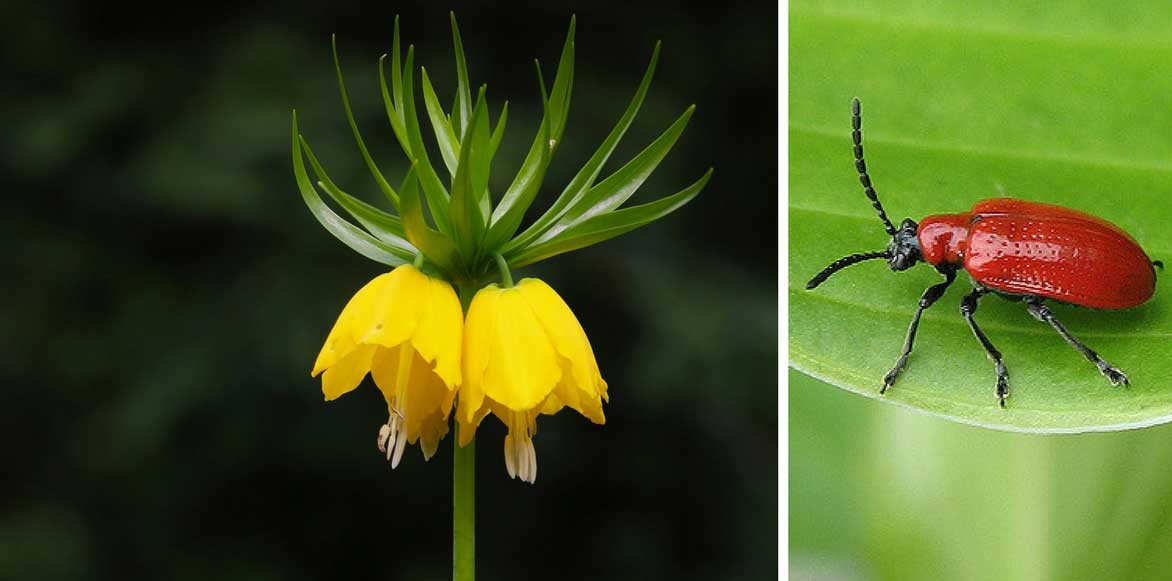 The lily beetle is the formidable enemy of fritillaries
The lily beetle is the formidable enemy of fritillaries
Check for its presence on your plants as soon as vegetation resumes; it appears from March to the end of July. Remove by hand and crush the adult insects. You can spread garlic powder at the base of the plants or spray tansy manure early in the season and continue until flowering, before the lily beetle emerges from the ground. An oily solution made from garlic and rapeseed oil sprayed on the plants will kill eggs and larvae. Repeat the application frequently until flowering.
Multiplication
Les Fritillaries se multiplient par sowing ou séparation des bulbilles en fin d’été, dès que le feuillage est bien sec. Il faudra attendre 5 ou 6 ans pour qu’un plant issu de sowing fleurisse, et 3 ans pour obtenir une belle floraison d’un plant issu d’une division des bulbes ou caïeux. La levée des graines de Fritillaries est longue et aléatoire, d’autant qu’un plant issu de sowing mettra plusieurs années avant de fleurir et que certaines espèces se ressèment volontiers naturellement. We recommend division, which is very simple to do.
Separation of bulblets
Les Fritillaries se multiplient rapidement par la production de bulbilles. After 3 or 4 years, you can divide the clumps et séparer les bulbilles formés autour du bulbe mère. Soyez patient : flowering will only occur after 3 years.
- Proceed at the end of summer when the leaves have yellowed
- Dig up the clump with a fork
- Gently separate the bulbs by hand or with a small knife
- Replant them immediately in the ground or temporarily in pots filled with a mixture of sand and potting soil
- Water without excess
→ Découvrez aussi how to multiply bulbs by scaling dans notre tutoriel !
Associate
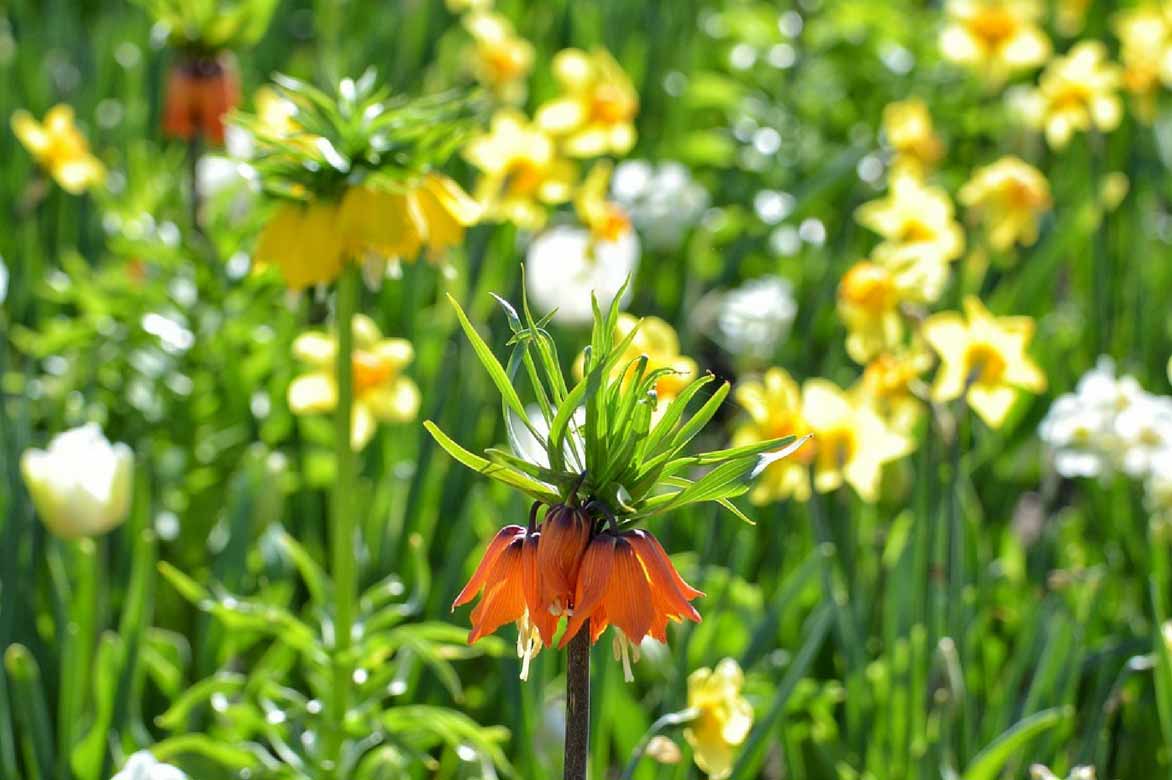
Fritillaries create beautiful associations with late narcissus and daffodils
Versatile, Fritillaria bulbs are very easy to combine and pair well with plants that, like them, require little maintenance. Imposing and architectural or bright yet discreet depending on the species, they thrive in the heart of spring, in naturalistic gardens without gardeners or weekend gardens or to add originality, height and graphic quality to exotic-style beds.
They create flamboyant and spectacular scenes in the background or centre of a bed or delicate and fresh compositions in borders or rockeries with purple or white accents.
Depending on the species, Fritillaries enjoy many situations; the taller ones should be planted in numbers for beautiful effects in well-drained beds, the smaller ones in woodland at the foot of trees, scattered in a lawn, to dress a border, in sunny rockeries or in spring pots.
The intense orange or bright red of a sculptural group of imperial crowns will harmonise with the warm orange/apricot/peach hues of early tulips William of Orange or the slender clusters of dark purple flowers of Fritillaria persica with Greigii botanical tulips ‘Little Red Riding Hood’, blood red. Yellow Fritillaries will be magnificent with viridiflora tulips.
The muted hues of some fritillaries pair well with the blue flowers of Siberian squills and muscari.
These exuberant bulbous plants will also find company with other equally easy-going bulbous plants; anemones nemerosa and blanda, hyacinths, Camassias, Chionodoxa, ipheions, ornamental garlic, anemones blanda, iris reticulata or erythrones.
The bright yellow-green of the inflorescences of spurge will highlight the mahogany sheen of the bells of a Fritillaria michailovskyi, as well as a background composed of the abundant golden yellow pompon-shaped flowers of Japanese cornel.
The characteristic foliage and flowers of Fritillaries will take on their full value when associated with medium-sized shrubs such as lilacs, deciduous azaleas, and Japanese maples with glaucous foliage. They create beautiful contrasts alongsidehostas with early foliage and the purplish leaves of heucheras.
For an exotic-inspired spring bed, mix the tall stems with the curiously cut foliage of Fritillaria imperialis with large perennials of generous habit, very graphic in appearance, that will take over like wormwoods or a Hungarian Acanthus.
Small species can settle in any scree garden or rockery, a sunny flowerbed or an elevated bed not far from the terrace, alongside snowdrops and hellebores, to admire their flowering from spring.
The Fritillaria melagris will thrive in a moist rockery, in pots, or under deciduous trees and shrubs or by a pond accompanied by perennials such as Astilbes, Siberian Irises, and marsh euphorbias to layer the bloom. It will naturalise in a lawn.
Some that fear moisture like Fritillaria bucharica are suitable for pot culture in a conservatory, on a balcony or terrace sheltered from rain, mixed with pansies, small narcissus cyclamen, crocuses, hyacinths or primroses.
Useful resources
- Our Depth Guide for Spring Bulbs
- The most beautiful and rare fritillaries are with us: discover our collection!
- Advice sheet: Bulb Size: Understanding to Choose Better
- Advice sheet: 6 Bulbs to Naturalise in the Garden
- Advice sheet: 4 Repellent Plants to Deter Moles
- Advice sheet: Botanical Fritillaries, the Most Beautiful Varieties
- Advice sheet: How to Choose a Fritillary?
- Subscribe!
- Contents
































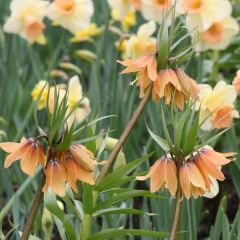

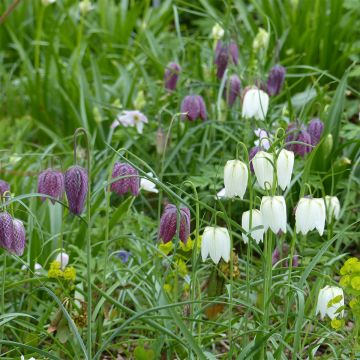
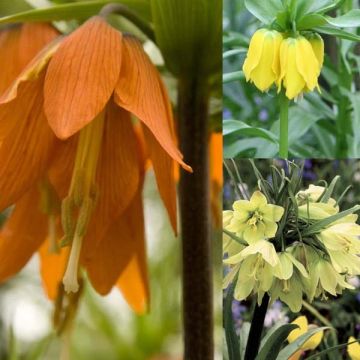
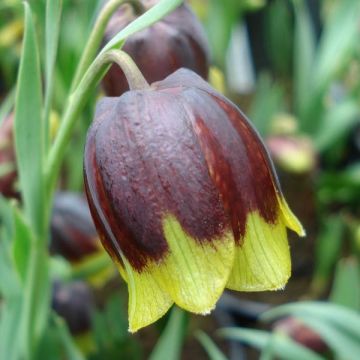
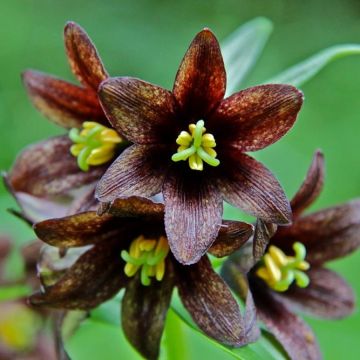
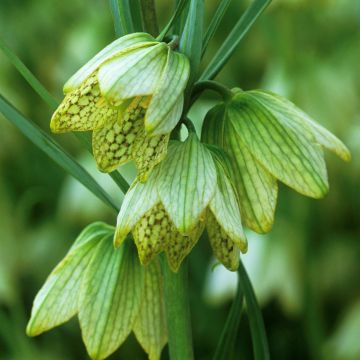
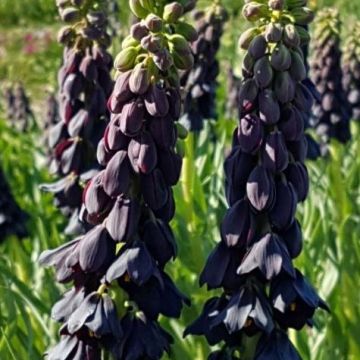
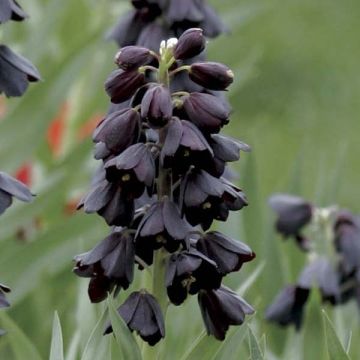
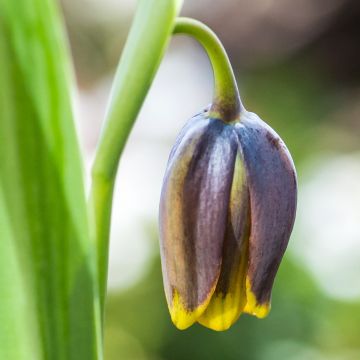

Feedbacks